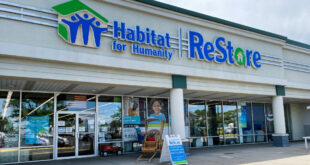Click the picture to download a PDF of this story.
By Jesse Carleton, jcarleton@nrha.org
For the past couple of years, the electric meter has been spinning backwards at Brinkmann’s True Value. In 2015, the company’s location in Miller Place, New York, achieved net-zero energy status, which means it produces more energy than it consumes.
According to Ben Brinkmann, who along with his brother Hank and sister Mary own the five-store business, their Miller Place location is the first retail store in the United States to achieve net-zero status. Their decision to go green was practical; the investment into a more energy-efficient operation will pay for itself in about four years and after that save thousands of dollars on energy costs. But going green also has a lot to do with setting an example for operating a business in a way that’s healthy for the environment and committing to excellence.
“We have always looked to do things the best way possible, in whatever we do,” Ben says. “Once we learned about the possibilities of going net-zero, we wanted to be the ones to reach it.”
Investing in the Future
At its core, Brinkmann’s True Value is a traditional hardware operation serving homeowners, contractors and commercial customers, with an emphasis on paint, lawn and garden and outdoor living.
“We’re fairly traditional in our product mix, but we separate ourselves by striving to be the best,” Ben says. “Nothing at Brinkmann’s is just good enough. We believe in constantly reinvesting in our business.”
That’s a set of values instilled by his parents, Tony and Pat. They opened their first 2,000-square-foot hardware store in 1976 in Sayville, New York, on a loan from Ben’s grandmother, Oma. Growth in the business came steadily. Over the next three decades, they increased square footage and added locations, including several standalone paint stores.
Achieving net-zero energy consumption was a lot more complicated than swapping out the lighting system for LED fixtures.
As the business was growing, the Brinkmanns were always close to the cutting edge of the industry. Ben was barely old enough to see over the edge of the counter when his parents added what was then the latest trend in the retail industry—a computer system.
“That was 1989, and computerization was still new. They were ahead of their time and one of the first in the industry to do that,” he says. Their paint store also had the first color-matching machine on Long Island.
In 2007, Ben and his siblings stepped in as the next generation of owners and continued their parents’ forward-thinking attitude. That included looking for ways to optimize the operational performance and customer service at each of their stores, whether that means an extensive remodel or relocating to a better site in town. For example, they decided to move their Sayville store to triple the store’s square footage and offer a more modern retail experience. They are also integrating design features that make for a better overall customer shopping experience, such as automatic doors, open floor plans, large windows to let in natural light and curbs that are flush to the parking lot. They also integrated the standalone paint stores into full-line hardware stores for a total of five locations in New York, including Miller Place, Blue Point, Holbrook, Jamesport and Sayville.

Aiming for Zero
So when it came to seeking out a way to make the store energy efficient, Ben’s drive for excellence didn’t slow down. Achieving net-zero energy consumption was a lot more complicated than swapping out the lighting system for LED fixtures. It required some major changes to their store’s physical structure. In fact, the Brinkmanns created their own construction company, Brinkmann Construction, to work on the project so they would have complete control over the building process and more freedom to make their own decisions. They also worked closely with PSEG Long Island, the local utility company, and GreenLogic Energy, a solar power panel contractor serving the Long Island area, to develop a plan that would result in a building that was efficient enough to have zero net-energy consumption.
Since the Miller Place location was due to be remodeled, the Brinkmanns decided to start there with their project. During an extensive renovation, they stripped the building down to its studs and began sealing up the structure with insulation. Large windows lend natural light to the inside, and LED lights only require a small amount of energy. The roof has a layer of insulation 1 foot thick, and is covered by a white thermoplastic membrane that reflects heat. Covering the membrane are solar panels, which provide the power the building needs for its minimal electricity needs.
The largest investment was a geothermal heating and cooling system. This system reaches 120 feet into the earth and uses the constant ground temperature to heat and cool the store. While it’s expensive to install, on average this type of system is 40 percent more efficient than traditional heating and cooling systems. It also requires no natural fuel to operate, and it receives all of the electrical power needed to run it from the solar panels.
Making the upgrades required a large up-front initial investment, but Ben expects to recoup the costs quickly. He received a variety of rebates from the federal and local governments, and PSEG, which reduced the installation cost by nearly 40 percent. With savings of nearly $35,000 per year in energy, his investment should pay for itself in less than four years.
Getting to net-zero means the building needs to generate as much, if not more, energy as it consumes. Miller Place arrived at that point in its first year after renovation.
To keep track of his progress, Ben uses a net meter, which is a type of meter designed specifically for energy customers who use solar panels to produce energy. When the building is producing more power than it needs, the meter runs backwards, indicating power is going back into the power grid. When that happens, the power company pays him for the excess power he generates. The first year, Ben received $18,000.

Leading the Industry
Brinkmann’s has already received accolades from PSEG as the first net-zero energy retail location in the state of New York. And in an article on its member website, membersonline.com, True Value recognized Brinkmann’s as the first net-zero retailer in its co-op. But Ben says achieving net-zero energy consumption is a milestone for the entire retailing industry, despite others who have claimed that spot.
In 2013, Walgreens made national headlines when it announced plans to build what it claimed would be the first net-zero energy store in the United States in Evanston, Illinois. The building design included new technologies, and store officials hoped it would be a model for retailers elsewhere. But in order to achieve net zero, a building must generate more energy than it consumes. A year later, in 2014, data showed the Walgreens facility had fallen short of that goal when averaging energy consumption over a year’s span of time, according to a report in the CIBSE Journal, a monthly magazine for building services and related professionals, in January 2015.
“We achieved net zero in our first year,” Ben says. “No other retailer that I know of can prove that, so I like to think that we are the first. We just didn’t get all of the national attention Walgreens did.”
Regardless of the absence of national fame, Ben and his family are forging ahead with a plan to be a completely net-zero energy company by 2025. They recently completed construction of their Sayville store, which will replace their existing operation in town. That 22,000-square-foot building includes office space for the company’s headquarters and should also generate more energy than it uses.
Ben promotes the unique energy-efficient features of the store to customers with his “Running on Sunshine” marketing campaign to explain to customers how the building is run completely on solar power. One piece of that campaign is an in-store diagram of the building showing how each of the systems work together to save energy. The program has been well received by his customers, and he hopes it will encourage others to consider what they can do to reduce their own environmental impact.
He also hopes his company becomes an example for other retailers who want to be not only more fiscally responsible and save money, but also show their care for the environment. Adding a geothermal HVAC system or installing solar panels may not be an option for everyone, but making the switch to LED lighting or upgrading insulation on the roof can offer big savings for low up-front costs.
“This initiative was really born from our love of the outdoors and our desire to be on the cutting edge of what’s happening,” he says. “This is something that will serve our family business well past the next generation.”
Learn more about Brinkmann’s at BrinkmannHardware.com.

 Hardware Retailing The Industry's Source for Insights and Information
Hardware Retailing The Industry's Source for Insights and Information









